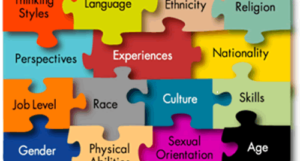
I was recently interviewed by telephone for a Diversity and Inclusion role- a role that I was very passionate about. I posted yesterday about it without referring to the role or organisation directly stating the following - "If your organisation finds itself interviewing a lesbian transgender woman, like me, and you find yourself telling them that LGBTI Inclusion is not a priority of your Diversity and Inclusion strategy, either you missed the point of D and I, especially the role it plays in recruiting the best talent, or you want them to make it a priority for you. I am going to be respectful and suggest it is the latter. During the phone interview I stated several times that LGBTI Inclusion is an essential element of gender equity and I stand by that.
I was invited to a face-to-face interview next week. Now it may seem a risky move to post to my LinkedIn about this but I figure I'm going to be saying the same thing in the face-to-face interview as I am writing here, and the beauty of writing it here is others get to understand how recruiters can get D and I wrong at the interview stage and how it often falls to those who identify as LGBTI to bear the burden of education. Additionally this particular organisation had asked for a thought leader. Thought leadership should be challenging to hear. It should be asking you to think extremely critically about your understanding. So I risk this role but I make a difference for D and I, particularly at organisations whose D and I is not mature. Additionally, if I convince the organisation that they can't do diversity in parts, if I convince them that LGBTI Inclusion is an essential part of Gender Equity and Cultural Inclusion maybe they will see a need not only to make it a priority but to employ me to make that happen. Then I will feel safe at my new workplace. Risky, but I am aiming for a win-win.
It is really important to understand that you can't do gender equity without LGBTI inclusion. Who are you being equitable to- cisgender, heterosexual women? That isn't diversity and it sure isn't inclusion. http://www.aauw.org/2014/03/24/lgbt-rights-are-civil-rights/ . Additionally it takes fewer resources and time to do inclusion properly, for all diversity, than it does to do it for just a few streams and it creates fewer objections.
As someone experienced in organisational change management, I immediately see massive challenges to a bit-part approach to diversity. Dealing with objections is a key part of organisational change management. When doing LGBTI inclusion separately, many organisations, particularly the more conservative ones will come up against objections. "Why are we doing this for the gays?" "Why are we raising this group above others?" Such objections are far easier to deal with when embedded in a wider diversity strategy. "We are not doing this for the gays, we are doing it for everyone."
Similarly when doing gender equity, those women who identify as lesbian, gay, bisexual, queer will feel excluded from the process. LBQ women face not only a glass ceiling based on gender but a double glazed glass ceiling due to gender and sexual orientation https://www.stonewall.org.uk/resources/double-glazed-glass-ceiling-lesbians-workplace .Perhaps lesbian transgender women like me face a triple glazed glass ceiling. Ensuring an organisation I work for is active in LGBTI inclusion and has it as an equal priority with gender is not just about my personal safety- though that is a significant issue. It is about doing diversity and inclusion properly. I like to do things properly. It may cost me the role but if an organisation wants me to work on their D and I strategy it is going to include LGBTI inclusion otherwise I'm not your person.